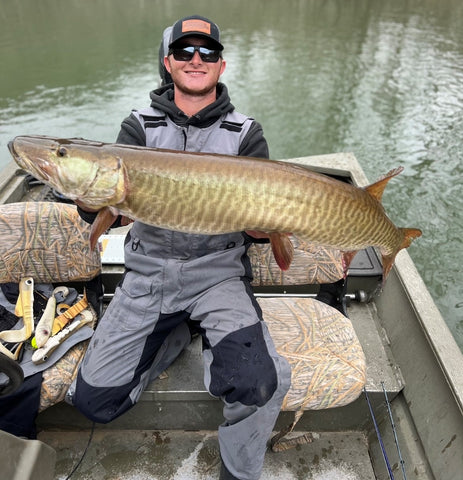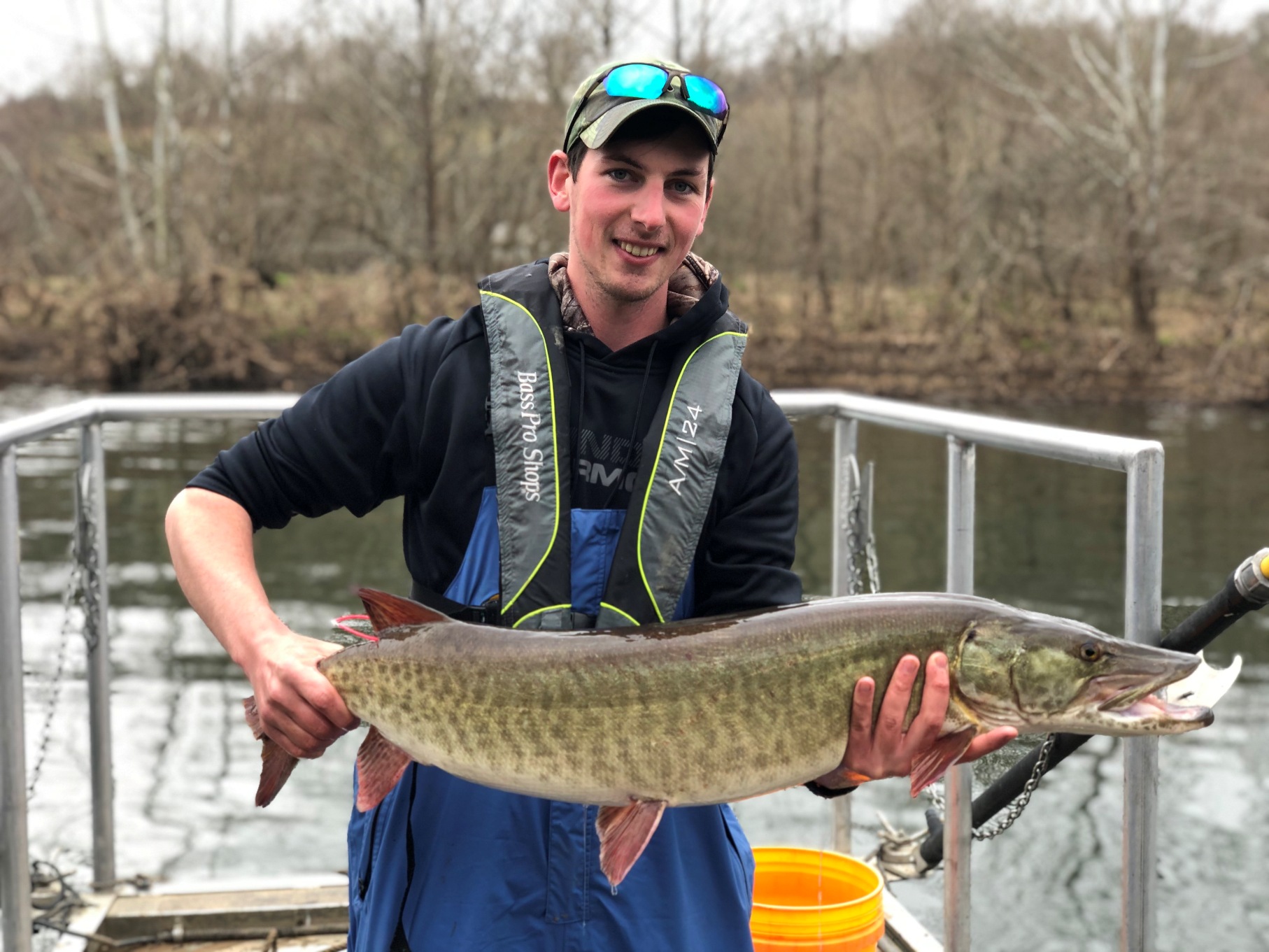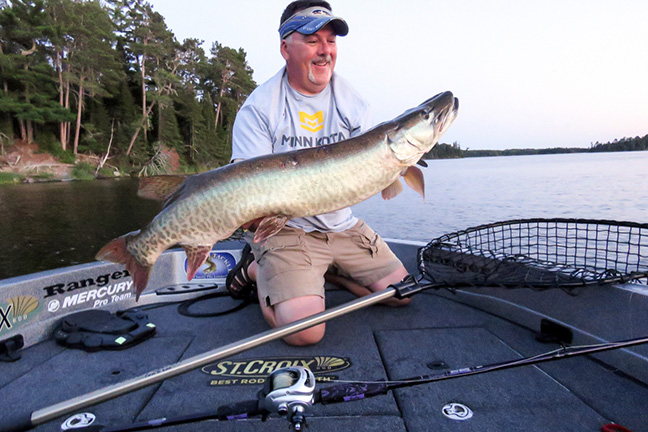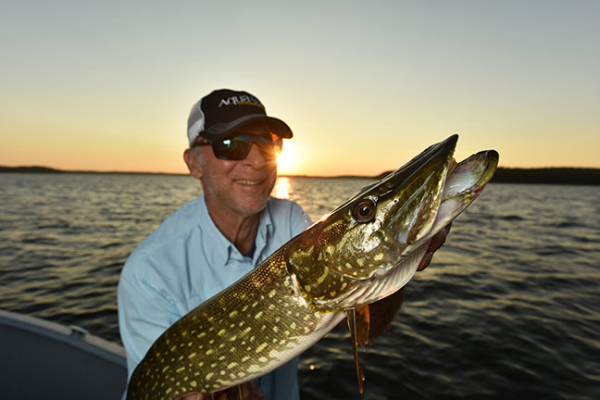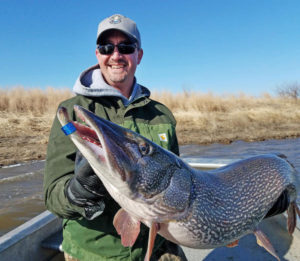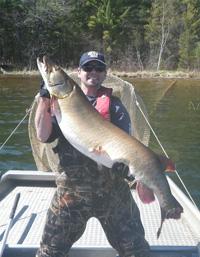
You have to be in the Right Place at the Right Time with the right tackle For 50-Pound Musky
- By The Fishing Wire
Park Falls, WI –Duncannon, Pennsylvania fishing guide and St. Croix Rod Ambassador, Joe Raymond, must be living right. Almost a month to the day after catching a 7.1-pound personal-best smallmouth bass that many believe to be the largest ever recorded on the Susquehanna River, Raymond caught another fish that has the internet buzzing. This one, however, was over twice as long and seven times heavier. No, it wasn’t a smallmouth bass.
“I was taking some time off and bass fishing up at the St. Lawrence River,” says Raymond, who always carries musky gear on the deck of his Rockproof River Rocket when plying the waters of the storied fishery. “I’m not a musky expert… just an enthusiast,” Raymond emphasizes. “I was scouting some new spots for bass the night before the full moon. Some of my areas have been getting a lot more pressure, so I was just exploring on my day off.”
Raymond was marking bass and working some scattered rocks along a grass line at about 5:00 PM when his Legend X spinning rod doubled over.
“I hooked a three-pound bass and was fighting it back to the boat when I saw a big musky charge up with gills flared right underneath it,” Raymond recalls. He describes the fish as a bona fide supertanker. “This fish was as fired up to eat as they come, but I couldn’t throw back at it because I wasn’t rigged up,” he says. Raymond unhooked the bass and hurriedly grabbed his musky rod.
After tying on a substantial chunk of white rubber, Raymond started fan casting with his Legend Elite Musky LEM86HF. “I couldn’t locate the fish on my electronics, so I was just casting and ripping the bait along that grass line,” he says. After about 20 minutes of rip… pause… rip, Raymond says his lure hard-stopped and he set the hooks into “all the weight in the world.”
The St. Lawrence River has some of the biggest muskies to be found anywhere and claims a historical world record – a 69-15 fish caught by Arthur Lawton in 1957. “Historical” because although the catch is still recognized as the NY state record by the New York Department of Environmental Conservation, it was disallowed as a world record by both the Freshwater Fishing Hall of Fame and the International Game Fish Association amidst much controversy – like so many other old musky records. That said, there’s no arguing that the St. Lawrence has produced numerous documented muskies over 50 pounds. Over the past few years, Raymond himself had already caught three fish there 55 inches or greater.

And he suspected the fish he was tied to might be his biggest yet.
“I was pretty sure the fish with my lure in its mouth was the same giant that had followed my bass to the boat,” Raymond says. “It was fighting like crazy… just dug and dug and dug, but I’ve been fooled before; I’ve caught 44-inchers that I swore were going to be a whole lot bigger. I had my drag totally locked down and was giving this fish everything my equipment and I had to get it into the net as quickly as possible.” When he got the fish near the boat, his suspicions were confirmed. “I’m sure it was the same fish,” he says. “Long, deep, and incredibly girthy all the way down through its tail. The fish was still punching and surging, but I saw it was well hooked, so I backed off the drag a half turn. I knew I had her.”
Raymond slid the giant into his net. He taped the fish at 55” long and 27” around.

“I was shaking and just wishing someone else was there to share the experience,” says Raymond, who spotted some people on a nearby beach and idled over with the fish in the net to ask for their help with a couple of photos. “They were interested in what I’d caught and were happy to help. They were so nice,” he says. While Raymond didn’t weigh the fish, he speculates it was somewhere just north of 50 pounds, making it the heaviest of his life — a statement backed up by common musky length/girth weight calculators.
After a couple quick photos, Raymond spent a few minutes observing the fish in the water before releasing it and watching the tank swim away.
Takeaways
When reflecting on the experience, Raymond wouldn’t comment on whether or not “living right” has anything to do with his recent good-fishing fortunes. But he does offer a few observations.
“If you spend enough time on the water you’re going to run into big fish,” he says. “And if you are spending that much time on the water, you’re going to have learned a lot and be a good angler. I don’t think there’s any more to it than that. I’m on the water all the time and it increases my odds of big-fish encounters.”
Raymond says he was fortunate to locate a trophy fish on a body of water known for giant muskies at the right time. “Anyone who puts time in chasing muskies knows what a grind it usually is,” he says. “Timing definitely matters. You can go days without catching or even moving one, then you hit a feeding window and the switch flips and you might see and catch several. That’s why I don’t guide for muskies; I really don’t want that kind of pressure… plus, I don’t want to ruin musky fishing for myself. I caught that big smallmouth on the same lunar period a month earlier – the day before the full moon. I was lucky to find both of those fish right when they were ready to eat.”
While Raymond wasn’t targeting muskies, he was prepared with the proper gear because of his knowledge of the fishery and his previous experiences there. “Like I said, I’m no musky expert, but I do make my living on the water, so I know the value of being prepared with the right equipment to take advantage of opportunities,” says Raymond, whose favored all-around musky setup is a St. Croix Legend Elite Musky 8’6” heavy power, fast action rod paired to a Tranx 400 reel spooled with 80-pound Smackdown braid tied with an FG knot directly to a custom Seaguar AbrazX 130-pound fluorocarbon leader.

“The 86HF is simply the most versatile musky rod you can get and anyone who’s fished the Legend Elite version will tell you it’s in a class by itself. It’s amazing how a rod that powerful can feel so unbelievably light. There’s always one in my rod locker when I’m fishing anywhere near muskies.”
Finally, Raymond dives into big muskies and what makes them so special… and so vulnerable.
“There have been fish like mine – and bigger – caught all up and down the St. Lawrence in the past decades,” Raymond says, “but they are becoming fewer and fewer. It’s sad to see what’s happened here. It’s still a viable destination and there are monsters here, just not as many. The water has really cleared up because of the zebra and quagga mussels, which has reduced the amount of grass and altered the fishery. And then you’ve got the VHS virus plus all the gobies eating most of the musky eggs. I don’t think the outlook is good. We don’t really see small fish here anymore, which is a bad sign.”
Raymond says if you are fortunate enough to catch one of these big, old St. Lawrence muskies – or a big musky anywhere – you’ve really got to be extra careful with them. “Other than taking a couple of photos and measuring it, this fish was kept in the water the whole time. That’s important. And when you do take them out, despite their size and how resilient they may seem, they’re actually more fragile than about any other trophy fish. Gravity alone can injure a fish like this, so how you lift and handle them matters.”
Whether you fish the St. Lawrence River or any other body of water where muskies swim, trophy fish time is happening right now and will continue through ice up. So, follow Raymond’s advice and get out on the water. They may be known as the “fish of ten-thousand casts,” but one of those casts could end with the fish of a lifetime.
Contact Joe Raymond or book a trip with him through his website, susquehannasmallmouthguides.com. Follow him on Instagram and Facebook.
About St. Croix Rod
Headquartered in Park Falls, Wisconsin, St. Croix has been proudly crafting the “Best Rods on Earth” for over 75 years. Combining state-of-the-art manufacturing processes with skilled craftsmanship, St. Croix is the only major producer to still build rods entirely from design through manufacturing. The company remains family-owned and operates duplicate manufacturing facilities in Park Falls and Fresnillo, Mexico. With popular trademarked series such as Legend®, Legend Xtreme®, Avid®, Premier®, Imperial®, Triumph® and Mojo, St. Croix is revered by all types of anglers from around the world.





